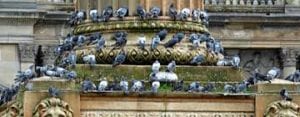THE PIGEON ISSUE
As one wanders through the great piazzas of Italy — the Piazza della Signoria in Florence, Piazza San Pietro in Rome, and the Piazza San Marco in Venice — one cannot help notice the magnificent facades of government buildings and churches, the impressive works of sculpture in marble and bronze, and… the pigeons. They have become tourist attractions in their own right, and for a small fee one can buy a bag of seed and turn oneself into a human bird feeder. The end result is predictable. As food is more than ample, the birds do not leave but multiply (the incubation period for a pigeon egg is a scant 17 to 19 days), and seeking homes nearby, they settle and nest on statues and buildings in close proximity. In turn, the pigeon waste, often inches thick, eats away at their surfaces, causing irreparable damage.
First of all, let me not suggest that Italy is the only country to face serious pigeon infestation. London’s Trafalgar Square is home to an estimated 30,000 flying citizens. Mayor Ken Livingstone actually used pigeon reduction as a campaign platform, effectively planning to starve them out, though his efforts have been thwarted by an animal-rights group, the aptly named Pigeon Alliance Issue.

What to do? A controversial, and by no means long term, solution is to “eliminate” the problem itself, and in fact, more pigeon carcasses have be seen on the streets of Florence in the last year or two. And yet the sale of feed in the piazzas continues, perpetuating a rather cruel and pointless cycle.
Yet if one cannot eliminate the pigeons, it seems that the next best option would be to keep the pigeons off of the statues and buildings altogether. To this end, high-tech solutions, even ridiculous ones, have been sought. Following the technicolor restoration of Maderno’s facade of St. Peters in Rome for the 2000 Jubilee, an electrostatic system was installed to repel the birds. And in a ironic twist, the town of Assisi in Italy has followed suit. Yes, the basilica founded by St. Francis, the saint who preached to the birds, has installed electric wires to discourage pigeons from landing on the 13th century building. They’ve even gone so far as to enact an ordinance that forbids their feeding in public spaces.
Statues have also been given an electric jolt. Most notably, Benvenuto Cellini’s Perseus, which underwent a 3-year long, highly-publicized restoration, complete with video-installation and CD-rom, was returned to its original outdoor location in the Loggia dei Lanzi in 2001, complete with pigeon-deterring wires. These raised electrified braces have also been attached to nearby Giambologna’s Rape of the Sabine, seemingly to no effect, since birds can still be found perched safely upon the desperate woman’s head. Clearly the aesthetic results are less than ideal, though in other cases riskier treatments have been applied, as in the case of the monument to Lord Nelson in Trafalgar Square, where the statue has been coated with what has been described as “anti-pidgeon gel”. At the very least, sculptures are covered with microcrystalline wax, as in the case of Bandinelli’s Giovanni delle Bande Nere, situated in the major pigeon colony of Piazza San Lorenzo, where the unfinished facade of the church has become some of the best avian real-estate in the city.
There are less-invasive alternatives. Protective netting can be mounted over architectural reliefs and the like to prevent occupation by birds. In Trafalgar Square, air horns have also been employed to scatter the animals, exchanging bird pollution for noise pollution.
In reality it seems that there are only two reasonable solutions to the pigeon issue. One has been implemented for quite some time, and is practical only in terms of sculpture, which is to move the originals inside. This not only has the benefit of “guano protection,” but also of preventing damage to works by other forms of environmental pollution. To have undergone the intensive restoration to the Perseus, only to subject it to the same conditions, is absurd, and only assures us that future interventions will be required, ad infinitum.
For architecture, the same solution cannot be implemented, but several protective measures seem feasible. For one, even if the complete cessation of pigeon-feeding has been deemed inhumane, at least the migration of the birds to a less urban area would suffice. In other words, should one want to feed the birds, it would be welcomed in a park, not a stones-throw from a major monument. And finally the caretakers of these monuments must commit to a plan of good old-fashioned washings on a regular basis, so that major, and inevitably harmful, interventions do not become necessary.
By Denise Budd from Source
About Pigeon Patrol
Pigeon Patrol Products & Services is the leading manufacturer and distributor of bird deterrent (control) products in Canada. Pigeon Patrol products have solved pest bird issues in industrial, commercial, and residential settings since 2000, by using safe and humane bird deterrents with only bird and animal friendly solutions.
At Pigeon Patrol, we manufacture and offer a variety of bird deterrents, ranging from Ultra-flex Bird Spikes with UV protection, Bird Netting, 4-S Gel and the best Ultrasonic and audible sound devices on the market today.
Contact us at 1- 877– 4– NO-BIRD, (604) 585-9279 or visit our website at www.pigeonpatrol.ca
Bird Gone, Pigeon Gone, Seagull Gone, Pigeon issue, pigeon spikes, 1-877-4NO-BIRD, 4-S Gel, Bird Control, Pigeon Control, bird repellent, Bird Spikes, sonic bird repellent, stainless steel bird spikes, bird spikes Vancouver, Ultra Sonic Bird Control, Bird Netting, Plastic Bird Spikes, Canada bird spike deterrents, Pigeon Pests, B Gone Pigeon, Pigeon Patrol, pest controller, pest control operator, pest control technician, Pigeon Control Products, humane pigeon spikes, pigeon deterrents, pigeon traps, Pigeon repellents, Sound & Laser Deterrents, wildlife control, raccoon, skunk, squirrel deterrent, De-Fence Spikes, Dragons Den, Canada bird spikes, Canada pigeon, pigeon control, pigeon patrol, pigeon. Kill pigeons, crow, starling
